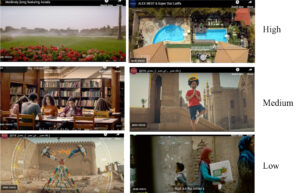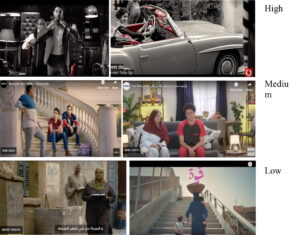Abstract
For over five decades, scholars have examined depictions of women and men in advertising and media, including the analysis of stereotypes, cultural implications, and social consequences. This research aims to analyze the relationship between target audience characteristics, such as gender and socioeconomic class, and the portrayal of women in Egyptian television commercials (TVCs), taking into account the level of product involvement[1]. The study analyzed 100 TVCs aired on Egyptian television channels over a period of thirty days. Three hypotheses were tested, and two of them were supported by the research findings. The study concluded that advertisements targeting both a higher socioeconomic group of consumers and women tended to portray women in a better light. Additionally, the level of product involvement did not have an impact on the portrayal of women in the commercials, regardless of high or low involvement.
Introduction
Erving Goffman's pioneering work in the 1970s laid the groundwork to better understand the complexities involving human interaction in various social contexts, which proved invaluable for advertising research. Goffman's concepts, such as impression management and dramaturgical analysis, provided a framework for scholars to analyze the role of advertising in shaping societal perceptions and behaviors. Yet, in the Arab world, advertising research only began to garner attention in the latter part of the 20th century. One notable study is that of Amine and Cavusgil (1983), which examined mass media advertising in Morocco. Their research shed light on the challenges and opportunities inherent in advertising practices within a developing nation. This study likely influenced subsequent research in other Arab countries, including Egypt. Another example is Luqmani, Yavas, and Quraeshi's (1989) investigation into advertising in Saudi Arabia, which offered insights into content and regulation practices within the Kingdom. Their work highlighted the unique cultural and regulatory landscape that shapes advertising strategies in the Arab region, which provides a framework for understanding similar dynamics in Egypt and beyond.
More recent research conducted by Khamis examined the reception and impact of advertising campaigns in Egypt. More specifically, Khamis (2009) explored Egyptian rural women's interpretations of televised family planning campaigns, which revealed the multiple meanings, identities, and resistances that are embedded in such messaging. The result of this study supports a previous study conducted by the same author in 2004 evaluating women in poor and marginalized urban neighborhoods in Egypt regarding the Egyptian Girl TVC, which provided insights into how such advertising campaigns are perceived and received by different socioeconomic groups in Egypt (Khamis 2004).
Abu-Lughod (2002) examined urban classist assumptions involving Egyptian drama creators and subversive counter readings of Egyptian serials by rural and working-class women, which provides additional comprehension regarding advertising and media reception in Egypt. The research revealed how media representations, which included advertising, are influenced by and perpetuate societal norms and power dynamics. Further, interpretations of Egyptian serials were disparate among different socioeconomic groups, which underscores the diverse perspectives regarding appropriate roles and self-esteem women should have within Egyptian society. This insight is valuable for understanding how various segments of the population in Egypt receive and negotiate advertising messages, particularly women from different socioeconomic backgrounds.
Prevailing trends, which includes the digital transformation of media landscapes, have influenced the evolution of advertising research in the Arab world. Allagui's (2019) book entitled Advertising in MENA Goes Digital, elucidated a shift toward digital advertising platforms in the Middle East and North Africa (MENA). This shift is particularly relevant for Egypt because digital media consumption has increased recently. More recently, Allagui's (2023) empirical model in The Dynamics of Advertising in MENA contributes to understanding the multifaceted factors that shape advertising practices in the MENA region. While the research is not specific to Egypt, the insights likely hold relevance for understanding Egyptian advertising within the broader context of the MENA region. Understanding this history of advertising research, especially more contemporary investigations conducted in the MENA region, is essential for contextualizing contemporary advertising practices, which this paper will examine. In addition to the aforementioned, comprehending the research involving depictions of women in advertising is also essential to this paper.
Scholars have studied the portrayal of women in advertising for more than half a century. Grau and Zotos (2016) published a comprehensive review of the literature, which examined three broad themes: stereotypes used to portray women and men in advertising, cultural implications, and social consequences. This paper aims to analyze the relationship between some target-audience characteristics, which include gender and socioeconomic class. Additionally, the research examined the level of product/service involvement and the portrayal of women in select Egyptian TVCs from a professional perspective. The study also sought to discern if the portrayal of women in Egyptian TVCs reflects reality or challenges it. Interestingly, both sociocultural norms and advertisements cyclically interact and influence the representation of women in TVCs by acting as mirrors and molds that reflect and shape portrayals of women (Zotos and Tsichla 2014). More specifically, advertisements often depict women to reflect sociocultural norms, but sometimes focus on unique representations of women to propose new realities (Amin and Khairy 2017). As such, our research question is:
- Do target-audience characteristics influence the portrayal of women in TVCs?
Target-Audience Gender
Gender comprises the roles that men and women adopt within society and culture. More specifically, this involves "systems of social differentiation such as political status, class, ethnicity, physical and mental ability, age and more, modify gender roles" (March et al. 2011, 17). The term gender, as well as the roles pertaining to each gender, are dynamic. The roles, responsibilities, behaviors, and characteristics that define men and women are all learned and shaped by culture, personal beliefs, and backgrounds (Owen 2020). As such, both men and women have different motives, perspectives, and considerations when purchasing specific products (Hys 2020; Tandon et al. 2020). Therefore, when women are the decision-makers involving specific product purchases, it would be counterproductive to portray women negatively in the product advertisements (Milfeld and Flint 2020). However, the opposite is not necessarily true. If the advertised product is targeting men, then the portrayal of women is subject to the discretion of the creative director, director, and brand manager. Therefore, our hypothesis (H1) is:
- H1: The more the Egyptian TVC targets women, then the more women are positively portrayed in the Egyptian TVC.
Socioeconomic Class
One aspect of socioeconomic classification categorize people based on their social and financial status. Additionally, the social aspect of socioeconomic classification considers education, occupation, living quarters, and belongings (Nielsen 2021). The combination of advancements in technology and a generational transformation has altered the entirety of the consumer ecosystem (Francis and Hoefel 2018). Nevertheless, despite some criticisms, marketing and advertising professionals still rely on socioeconomic factors as a viable means of segmenting and targeting consumers and positioning brands (Gilboa and Jaffe 2021; Williams 2019).
When brand managers target higher individuals in socioeconomic groups, they know women in these group are generally more educated, empowered, and expressive. As such, they tend to demand respect (Zeitoun 2018). Unfortunately, the opposite is also true (Lui et al. 2006). Moreover, creative directors usually choose specific models, settings, and music to resonate with their target audience (Taylor and Madden 2012). We postulate a positive relationship between the targeted socioeconomic class vis-à-vis the portrayal of women in the advertisement under investigation. We identified the targeted socioeconomic class in the advertisement via the language, settings, lyrics, music genre, and casting (models) used in the advertisement. As such, our second hypothesis (H2) is:
- H2: The higher the level of socioeconomic class an Egyptian TVC is targeting, the more positively women are portrayed in the Egyptian TVC.
Product Involvement
In advertising, the creative direction is highly affected by product involvement. Low-involvement product advertisements use more emotional, hedonic, and fun appeals, which transmit along the peripheral route to persuasion (Mardhatilah, Omar, and Septiari 2023). High-involvement products are reliant upon more logical, rational, and fear appeals, which follow the central route to persuasion (Petty, Cacioppo, and Schumann 1983). Low involvement purchases, which are typically associated with low risk and price, generally do not involve or require planning prior to acquisition (Petty and Cacioppo, 1986). Consumers will often exert minimal effort in decision-making when low importance or minimal adverse consequences may be the outcome of erroneous purchase decisions (Ferreira and Coelho 2015).
Products or services related to consumer values, lifestyles, and experiences are likely associated with higher involvement. However, no product has the same level of involvement since such variables are idiosyncratic for each individual (Wrenn et al. 2014). Product involvement escalates as price increases, which involves more effort and time when deciding whether to make a purchase that is expensive, risky, or irreversible (Abdel Wahab, Diaa, and Nagaty 2023). The impact of TVC messaging is increased in a viewer who exhibits high involvement, as the details of the message can alter the beliefs and attitudes of the viewer (either positively or negatively) (Mogaji 2021). If women are portrayed positively, then the positive depiction should positively affect the beliefs and attitudes of the viewer regarding the product and vice versa (Omowale 2023). Thus, the third hypothesis (H3) is:
- H3: The more the Egyptian TVC is for high-involvement products/services, the more women are portrayed positively.
Methodology
This research examined the portrayal of women in selected Egyptian TVCs during the month of Ramadan. In Egypt, viewership triples during the holy month. As a result, television channels and producers compete to attract viewers, which correspondingly precipitates an increase in TVCs. More specifically, ad agencies and clients launch seventy percent of new advertising campaigns during Ramadan (IMS 2021). The sampling frame was a census of all TVCs broadcast on channels freely accessible to the Egyptian public for thirty days[2]. From this sample, the research identified a total of 712 unique TVCs and 100 of these met the criteria of the study.
The research criteria excluded all public announcements, non-governmental organization, and charity, as well as general TVCs (e.g., Coke or Pepsi) that broadly target everyone. These types of TVCs were removed from the sample because the independent variables in these would be confounding and vague. We naturally omitted TVCs that did not include women because the dependent variable would be unmeasurable. Finally, we excluded redundant campaign TVCs, unless the campaign had several unique versions of the TVC with different creative ideas, settings, models, and target audiences.
Measurement of Variables
Portrayal of Women
We measured the portrayal of women using the interval scale developed by Lundstrom and Sciglimpaglia (1977) to examine role portrayals. The Lundstrom and Sciglimpaglia interval scale consists of twelve statements. However, six of these statements were discarded because they are generic and do not pertain to TVCs. The six remaining statements from the Lundstrom and Sciglimpaglia interval scale were modified in syntax and grammar to fit the purpose of the research. The Likert format was adopted for ease of use and reliability. Table 1 displays the items and the loadings for the confirmatory factor analysis for all the variables in the study.
Target Audience of the TVC
The target audience was measured on a five-point interval scale, which are TVC targets: men only, mainly men, targeting both men and women, mainly women or women only. The scale quantified the intended target audience of the advertisement from one (meaning only men) through to five (meaning only women). Additional explanation was provided during coder training for the three middle points (mainly men, targeting both men and women, and mainly women). Category two (mainly men) indicates the TVC message targets men, although sometimes women may buy the product, typically as a gift. Category three (targeting both men and women) indicates the TVC message is aimed at both men and women. Finally, category four (mainly women) indicates the commercial mainly targets women, although sometimes men may buy the product as a gift.
Socioeconomic Group
Behaviorally Anchored Rating Scales (BARS) were adopted for this research. BARS assessed performance with scale points containing specific behavior examples. More specifically, the BARS scale was used to determine the TVC socioeconomic (SEC) orientation, which describes particular standards to ascertain if the TVC targeted high, middle, or low SEC. BARS assessed the socioeconomic class in commercials based on four factors: setting, jingles/lyrics, language, and cast (e.g., choice of models and apparel). These four factors were used to determine the socioeconomic group targeted in the sample of TVCs under examination, which were then divided into three categories: high, middle, and low SEC. The four elements were derived from Taylor and Madden (2017) (see Table 1).
| Table 1: Operationalization, CFA loadings, and reliability | |
| The portrayal of Women Cronbach's alpha = 0.80 | Factor Loading |
| Q5 This ad suggests that women are fundamentally dependent upon men | .702 |
| Q6 This ad treats women mainly as "Sex Objects." | .566 |
| Q7 This ad suggests that women make important decisions | -.689- |
| Q8 This ad suggests that women do important things | -.827- |
| Q9 This ad suggests that women's place is in the home | .541 |
| Q10 I find the portrayal of women in this ad to be offensive to women. | .840 |
| Target-audience Gender | |
| Q11 Please specify the gender targeted in the ad: Men Only (1); Mainly Men (2); Men & Women (3); Mainly Women (4); Only Women (5) | |
| Socioeconomic Class. Cronbach’s alpha = 0.95 | Factor loadings |
| Q12 Based on the definitions mentioned in the Code book, Please specify the level of the setting in the ad (High – Middle – Low) SEC | .913 |
| Q13 … Please specify the jingle/lyrics used in the ad (H-M-L) | .909 |
| Q14 … Please specify the level of language used in the ad (H-M-L) | .877 |
| Q15 … Please specify how the cast appeared in the ad (H-M-L) | .922 |
| Product Involvement. Cronbach’s alpha = 0.95 | Factor loadings |
| Q16 The product or service offered in the Ad is: Very Inexpensive as (1) to Very expensive as (5) | .916 |
| Q17 The product or service offered in the Ad is: Very Low Risk as (1) to Very High Risk as (5) | .942 |
| Q18 The product or service offered in the Ad is: Easily Reversible purchase decision as (1) to Irreversible purchase decision as (5) | .917 |
Setting
The setting of the commercial was measured on its appeal to high, middle, and low SEC. The high SEC settings include luxurious locations, golf courses, pools, villas, etc. The middle SEC settings would present as affordable and accessible to most people, which include standard cafés, average home kitchens, and public parks. The low SEC settings are typically slums, poor or crowded areas, not clean, tidy, or well-built (see Figure 1).
Figure 1. Setting as an indicator of socioeconomic class
Jingle /Lyrics.
The high SEC TVC jingles and lyrics were classy, clever, and sometimes foreign. The middle SEC TVC jingles relied on popular music and the lyrics were colloquial and candid. In contrast, the low SEC TVC jingles were loud, vulgar, and the lyrics included graphic language with trendy slang expressions.
Cast
The cast in the high SEC TVCs wore high-end and expensive brands. Most of the items the cast used or owned in the TVCs were expensive and their gestures alluded to wealth. The cast in the middle SEC TVCs wore casual, affordable, and average clothes. The cast in the low SEC TVCs would be exhausted, ill-groomed, and poorly dressed in local outfits (see Figure 2).
Product Involvement
The level of product involvement mainly depended on three factors (see Table 1). If the purchase decision involved higher price, risk, and irreversibility, then the higher the product involvement and vice versa. We measured each factor on a five-point semantic differential scale ranging from one (low) through to five (high).
Figure 2: Cast as an indicator
The study analyzed 100 unique Egyptian TVCs that aired during Ramadan. This sample was randomly classified into four groups, which consisted of twenty-five TVCs. Each of the four groups were assigned two coders and coded twice. The authors conducted a workshop to train the coders. To effectively train the coders, ten mock TVCs were selected from the sampling frame for training. The coding sheet was explained in detail, the coders coded the mock TVCs, and their coding sheets were collected. All responses and discrepancies were discussed and clarified. After the training, the coders were assigned their tasks and carried out their work. After data entry, Cohen's Kappa was calculated and revealed a good interrater reliability of eighty-one percent.
Findings
H1: The more the Egyptian TVC targets women, the more women are positively portrayed in the Egyptian TVC
Regarding H1, the dependent variable was the portrayal of women. The independent variable was the target gender in the TVC, which was measured on a five-point scale (men only, mainly men, both men and women, mainly women, only women). We analyzed variance (ANOVA) to test if women were more positively portrayed if the TVCs targeting women (see Table 2). The analysis revealed a positive significant relationship F(4, 195) = 8.170, (p = .000), which supports the first hypothesis.
H2: The higher the socioeconomic class targeted in the Egyptian TVC is targeting, the more positively women are portrayed in the Egyptian TVC.
Regarding H2, the independent variable was the socioeconomic (SEC) group targeted by the TVC (see Table 1). We performed an analysis of variance (ANOVA), which was reported in Table 2, to test if women were more positively portrayed if the TVCs targeting women. The analysis revealed a significant positive relationship for all four indicators of socioeconomic class, thus supporting the second hypothesis.
H3: The more the Egyptian TVC is for a high-involvement product/service, the better women are portrayed.
The dependent variable was the portrayal of women. The independent variable was the product involvement level of the advertised product or service. We performed an analysis of variance ANOVA, which was reported in Table 2. The results indicated that none of the three indicators of product involvement were related to the portrayal of women, which refutes the third hypothesis.
| Table 2: ANOVA for the three target audience characteristics and the portrayal of women.
|
|||
| DV: Portrayal of Women | |||
| Independent Variable | F | df | sig. (p) |
| Q4. Target Gender | 8.170 | 4, 195 | .000** |
| Socioeconomic Class | F | df | sig. (p) |
| Q12 Setting SEC | 3.854 | 2, 196 | .023* |
| Q13 Jingle/lyrics SEC | 3.077 | 2, 167 | .049* |
| Q14 Language SEC | 5.771 | 2, 188 | .004** |
| Q15 Cast SEC | 3.075 | 2, 197 | .048* |
| Product Involvement. | F | df | sig. (p) |
| Q16 Expensive | 0.610 | 4, 195 | .656 |
| Q17 Risky | 1.035 | 4, 195 | .390 |
| Q18 Irreversible | 0.439 | 4, 195 | .780 |
| *p<0.05 **p<0.01 | |||
Discussion
The study analyzed the portrayal of women in Egyptian TVCs, particularly as it pertained to the gender and socioeconomic group targeted by the TVC, as well as the level of product/service involvement. Our findings corelate with recent research, which reveals the more a advertisement targets women as the decision-maker, the more women were positively portrayed (Sandhu 2022). If this were not true, then this may impact the purchase process and could adversely affect brand identity (Elmi 2023).
The literature also concurs with our findings regarding the higher the level of socioeconomic class targeted in an advertisement, the more positively women were portrayed (Thomas and Treiber 2005). Further, the findings in our research indicates that high socioeconomic women have high levels of awareness and would not accept seeing women represented negatively. Moreover, it also found that some TVCs targeting the low socioeconomic group portrayed women as strong, powerful, and capable of raising their children. Amin and Khairy (2017) proposed a gender-based media code for Egyptian television, which stipulated that women of any socioeconomic class should be portrayed equally and fairly. Holtzhausen, Jordaan, and North (2011) reported that South African advertisers link women to consumer decision-making for low-involvement products, rather than for high-involvement products. Further, women were seldom represented in product categories that are high-involvement products, such as electronics. Our research found no relationship between product/service involvement and the portrayal of women in TVCs in Egypt.
Finally, the study explored whether TVCs in Egypt resonate with or challenge society. There seems to be some progress regarding this issue when compared to the outdated negative stereotypes traditionally associated with women. However, the researchers would not describe these incremental changes as challenging social norms. The more progressive TVCs were more a reflection of reality and even these TVCs needed further progress to accurately represent the real world.
Arab media should work to change or remove negative depictions and produce more positive representations of women. Moreover, Arab media should devote more attention to women of all categories, which include rural, poor, young, aged, disabled, and unmarried women (Allam 2008). Furthermore, Arab media should fairly cover women and portray them as productive members of society. Arab media should also present women as leaders and decision-makers, not followers. There should be strict policies and rules that forbid any negative portrayal of women in advertising.
We conducted a focus group to enrich our understanding of the quantitative findings and enhance the research. The focus group was held for ninety minutes, which was comprised of five women and three men that included three senior marketing consultants, a creative director, two ad agency account managers, an adjunct professor of marketing communication, and an associate professor of gender studies. It was moderated by one of the authors. The moderator explained the research to the focus group and then deliberated the findings individually.
The first discussion examined why women were portrayed more positively when the advertisement targeted women. Arguments included that decision-makers must be presented positively in order to identify with the positive image in the TVC. One female participant elaborated that portraying women who consume the product as strong would motivate viewers to purchase. One focus group participant, a female professor, indicated the main objective of advertising is to sell a product or a service, which means what is presented may not always comport with reality. However, it can be logically concluded that most women prefer to see positive female depictions. Further, advertising and psychology are interrelated. Therefore, it was essential to play on the psychology of women and portray them in a manner they prefer. During the focus group, one of the ad agency account mangers indicated that although women are the primary decision-makers in purchasing most products, their opinion matters even when they are not involved in the decision-making process. As such, women will often be portrayed positively in TVCs that target men because their opinions still mattered. However, they agreed that some TVCs portray women negatively when the advertisement targets only men, which may be an attempt to appeal to men. Meanwhile, another professor commented that the perception of positive or negative portrayal depends on the viewer's value system and psychographics.
The moderator then disclosed our second finding regarding women tending to be more positively depicted when an TVC targets the high socioeconomic consumers. The focus group believed this is normal because women in the high socioeconomic group typically exhibit heightened awareness and self-esteem. As such, women in the high socioeconomic group would not accept being demoted. Furthermore, the focus group indicated their contention that TVCs indented for the low socioeconomic group would still represent women positively, strong and intelligent. The low socioeconomic TVCs represent women as super mothers who effectively raise their children, as they are often depicted as working day and night to provide their children with the best quality of life. When relevant, the low socioeconomic TVCs represent the target group as frugal and value experts, which render women in this target social group as proud. Moreover, these TVCs often recognize and celebrate these aforementioned achievements.
The mirror or mold debate (Nguyen 2021) was raised during the focus group when a male participant referenced an advertisement that presented a young woman in the low socioeconomic group who was depicted as worried because her cooking was not perfect, which would bring shame to her family. The solution to her anxiety was to use the advertised brand of shortening. The advertisement mainly targeted women in the low socioeconomic group and the representation could be considered as negative. However, the creative director argued that such a portrayal is not offensive to the cultural sensitivities of this socioeconomic group. Moreover, marketers mirror this reality. However, other focus group members disagreed and felt this representation was indeed negative, even if some of the content may have been grounded in reality. Most of the focus group felt this advertisement was offensive to women, regardless of their socioeconomic status.
Finally, the moderator disclosed the research findings regarding the portrayal of women was not affected by the level of involvement with the product or service. In the resultant discussion, focus group participants recalled real estate or automobile TVCs that portrayed women positively or used women as beautiful objects. Other examples were discussed, which resulted in concluding that no relationship involving level of involvement seems to be apparent.
The focus group members believed that Egyptian TVCs were not challenging societal norms. More specifically, the group agreed that culture instigates what should be represented in the TVC and not vice versa. Egyptian TVCs, and advertisements in general, only typify societal norms without aiming to change or challenge it. There is noticeable progress in the portrayals of women, argued an account manager, but it is not enough to challenge reality or genuinely advocate for new ideals. If there is a slow shift to represent empowered women, as opposed to a more traditional depiction of disempowered women, then it generally lags behind societal norms.
There was some interesting insight from the two marketing consultants regarding this issue, which felt quite strongly because of their experiential knowledge. They explained the portrayal of women in advertising is driven by those paying for the advertisement, as well as those who brief the agency with explicit or implicit directions regarding the tone of the commissioned advertisement. Even if the agency disagrees with the tone or concept, the client can overrule the agency or find another agency that is willing to produce the desired advertisement. As such, the pressure of competition often ensures the agency acquiesces to the client’s wishes.
Limitations and Future Research.
This research has several limitations, which include a sampling frame drawn from TVCs broadcast on Egyptian television during thirty days. Expanding the sampling frame, which would include increasing the duration of the sample as well as expanding the broadcast area to include additional (non-Egyptian) Arab media outlets could help develop a Pan-Arab comprehension of this issue (Allam 2008). Additionally, replicating this research in any MENA country or within the Arab region would both answer and raise questions. Moreover, online advertising is outpacing TVCs and rapidly becoming a reasonable substitute for broadcasting audiovisual advertisements. Therefore, we suggest future research should be directed toward online advertising. Additionally, further research could incorporate other new, as well as traditional, media advertisements.
The research conducted in this paper is limited to three customer characteristics, which are target gender, socioeconomic class, and product involvement. The findings indicate a need to expand upon this research by incorporating other aspects such as demographics, psychographics, and personas of the target audience, which may reveal their impact on women's portrayal. Another potential area for research could build upon the comments made by the two marketing consultants in our qualitative focus group. More specifically, the comments pertain to the decision makers who produce the portrayals of women in TVC. We believe this is an area that researchers have overlooked. We suggest qualitative research to develop a better understanding of the cognitive, affective, and behavioral underpinnings involving an executive’s decision-making. As business and advertising underpin all depictions of women in advertising, it puts a social and moral responsibility on the shoulders of the executives and management who make these decisions.
Finally, we envision an ecosystem approach to examine the different players influencing and shaping the portrayal of women in media. The ecosystem includes media companies, ad agencies, business entities, social media platforms, consumers, regulators, pressure groups, creative directors, and copywriters. The dynamics involving these parties must be determined, tested, and well understood. Academics from all related fields, including but not limited to gender studies, sociology, psychology, communication, and marketing, should endeavor to explore and explain the phenomenon with all its dimensions and richness.
The Authors have not received any funding and have no conflict of interest.
The research did not include human subjects and a waiver was obtained from the university Institutional Review Board.
[1] Low involvement is typically associated with low risk and price, which pertains to a purchase that does not involve much planning or thinking prior to purchase (Petty and Cacioppo 1986). Product involvement will increase as price and risk increases, which correspondingly involves more effort and time deliberating the purchase because it involves an expensive, risky, or irreversible purchase decision (Abdel Wahab, Diaa, and Nagaty 2023).
[2] These channels included MBC, CBC, DMC, Al Kahera Wal Nas, Sada ElBalad, Almehwar, Hayah, and Channel 1. The census was acquired by the authors from www.acumen.me , which is a media intelligence agency for purpose of this research only.
Alia El-Mohandes is a researcher in the Department of Journalism and Mass Communication in the School of Global Affairs and Public Policy at the American University in Egypt.
 Arab Media & Society The Arab Media Hub
Arab Media & Society The Arab Media Hub







